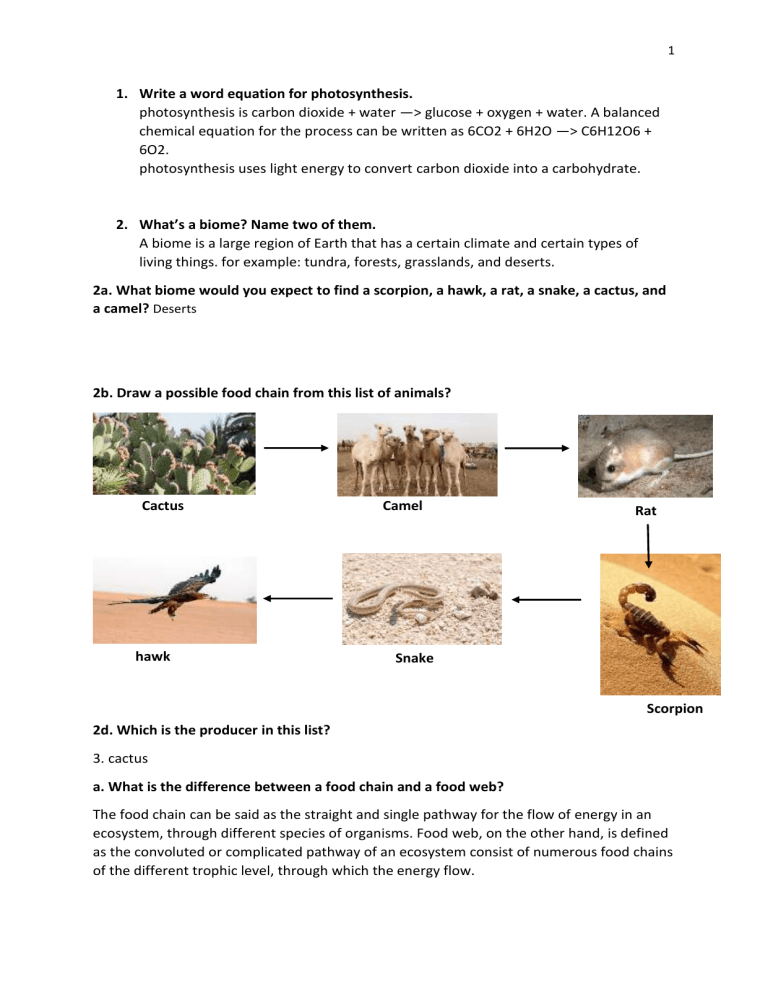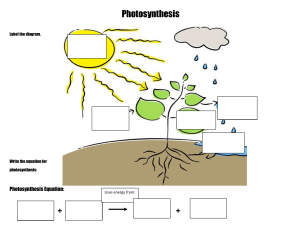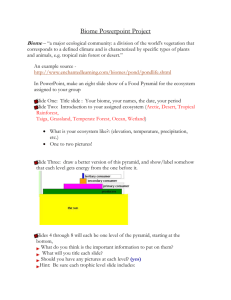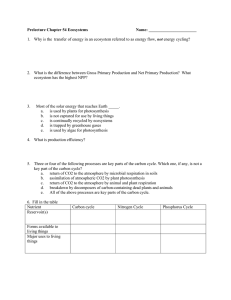
1 1. Write a word equation for photosynthesis. photosynthesis is carbon dioxide + water —> glucose + oxygen + water. A balanced chemical equation for the process can be written as 6CO2 + 6H2O —> C6H12O6 + 6O2. photosynthesis uses light energy to convert carbon dioxide into a carbohydrate. 2. What’s a biome? Name two of them. A biome is a large region of Earth that has a certain climate and certain types of living things. for example: tundra, forests, grasslands, and deserts. 2a. What biome would you expect to find a scorpion, a hawk, a rat, a snake, a cactus, and a camel? Deserts 2b. Draw a possible food chain from this list of animals? Cactus hawk Camel Rat Snake Scorpion 2d. Which is the producer in this list? 3. cactus a. What is the difference between a food chain and a food web? The food chain can be said as the straight and single pathway for the flow of energy in an ecosystem, through different species of organisms. Food web, on the other hand, is defined as the convoluted or complicated pathway of an ecosystem consist of numerous food chains of the different trophic level, through which the energy flow. 2 b. Why is a food chain more specific than a food web? The food web provides a better model of an ecosystem because the food web is a model between MANY different consumers and producers in an ecosystem. While the food chain is a model for just one consumer and producer, because energy is lost as it moves from producers to consumers, the bottom level is the largest. 3. Why are phytoplankton and zooplankton important? Photosynthesis by the phytoplankton accounts for up to half of global primary production. 5. Draw a simple energy pyramid and label it using the terms primary, secondary, and tertiary consumer, and producer. How many trophic levels are there in your pyramid? Why is a pyramid used to depict the energetic relationship between the trophic levels? 6. Define each of the following terms. Term 1. Biotic 2. Abiotic 3. Population 4. Community 5. Niche 6. Habitat 7. Invasive species 8. Extinction Definition Biotic factors are the living parts of an ecosystem. A non-living condition or thing, as climate or habitat, that influences or affects an ecosystem and the organisms in it Population means the number of people in a geographic area. It can also be used for subgroups of people or animals. Is a group of living things sharing the same environment. Refers to the way in which an organism fits into an ecological community or ecosystem. A habitat is an area that is lived in by a particular species of animal, plant, or other type of organism. It is the natural environment in which an organism lives, or the physical environment that surrounds a population. An invasive species is a species that is not native to a specific location, and that has a tendency to spread to a degree believed to cause damage to the environment, human economy or human health. considered to be the death of the last individual of the species, although the capacity to breed and recover may have been lost before this point. 3 9. Photosynthesis the process by which green plants and some other organisms use sunlight to synthesize nutrients from carbon dioxide and water. Photosynthesis in plants generally involves the green pigment chlorophyll and generates oxygen as a by-product. 10. respiration respiration is the movement of oxygen from the outside environment to the cells within tissues, and the transport of carbon dioxide in the opposite direction 11. Chlorphyll Chlorophyll is any of several related green pigments found in the mesosomes of cyanobacteria, as well as in the chloroplasts of algae and plants. 7. How many types of craniates are there? Name them. 7 types, 1: X-ray tetra fish 2: Puppies 3: Amphibians 4: Reptiles 5: Birds 6: Mammals 7: Hagfish 8. What are the different kingdoms of living things? Monera, Protista, Fungi, Plantae, Animalia, 9. How do you know a car isn’t alive whereas a dog is? Explain. dog define life because have those characteristics sensitivity or response to the environment, reproduction, adaptation, growth and development, homeostasis. and car not. Also, dog need water, food ,breath and shelter. 10. How many different types of arthropods are there? Name them. There are four major groups of arthropods Chelicerata (includes spiders and scorpions) 4 Crustacea (shrimps, lobsters, crabs, etc.) Tracheata (arthropods that breathe via channels into their bodies; includes insects and myriapods) extinct trilobites – have heads formed of various combinations of segments, with. 11. What are the 5 main groups of plants? Plants include familiar types such as trees, herbs, bushes, grasses, vines, ferns, mosses, and green algae. 12. Draw the leaves of two different kinds of flowering plants below 5 13. Compare and contrast Mitosis and Meiosis in a human. 14. Correct order: Plant Only 1. Ribosome Plant & Animal Function Is to synthesize proteins as directed in the messenger RNA. 2. Large central The main function of the large central vacuole vacuole in plant cells is to provide structural support. 3. Cell membrane The cell membrane gives the cell its structure and regulates the materials that enter and leave the cell. 4. Cell wall This is accomplished by the cell wall creating a skeleton-like frame that enables 6 plants to grow vertically and develop a rigid stem. 5. Mitochondria Mitochondria are often referred to as the powerhouse of the cell. 6. chloroplast Chloroplasts are the part of plant and algal cells that carry out photosynthesis. 7. Nucleus The key function of the nucleus is to control cell growth and multiplication.



